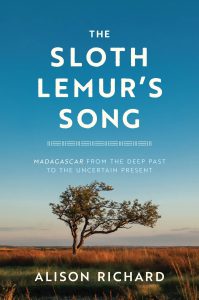5 Questions with Alison Richard, author of “The Sloth Lemur’s Song: Madagascar from the Deep Past to the Uncertain Present”
Madagascar is a place of change. A biodiversity hotspot and the fourth largest island on the planet, it has been home to a spectacular parade of animals, from giant flightless birds and giant tortoises on the ground to agile lemurs leaping through the treetops. The Sloth Lemur’s Song is a far-reaching account of Madagascar’s past and present, led by an expert guide who has immersed herself in research and conservation activities with village communities on the island for nearly fifty years. We spoke with Alison Richard to learn more about Madagascar and her hopes for its future.
You’ve spent over fifty years studying Madagascar. How did you first come to study the island, and what do you love about the work?
I spent the summer of 1968 watching monkeys on an island in the Panama Canal. Returning to Cambridge University for my final year as an undergraduate, I took a class with Alison Jolly, the late primatologist and Madagascar expert. She showed us slides of spiny forests in the south, and I fell in love with them. She asked how my summer project had gone, and I told her I would never watch primates in the wild again: poisonous snakes, rain, animals hard to see. . . “Oh,” she said, “come to Madagascar—no poisonous snakes, dry forests, and animals easy to see!” So I did. There were a few other reasons too, of course: around 95% of the plants and animals are unique to the island, and it is a hothouse for evolutionary experiments.
What do I love about the work? Watching animals go about their lives in the trees, feeling like the most privileged person in the world when they trusted me enough to come down to the forest floor and sit nearby; also and equally, the deep friendships formed over many years collaborating with Malagasy colleagues and the village communities around the forest.
In The Sloth Lemur’s Song, you explain that Madagascar is home to a vast array of plants and animals that are found nowhere else in the world. Can you give us a few examples of these plants and animals you study, and how did they come to be there?
For plants, take the family Didiereaceae, with 11 living species, including the magical, silvery trees studded with spines that enchanted me long ago. I don’t know how the Didiereaceae family came to be in Madagascar. Its origins lie tens of millions of years in the past, and it has no close living relatives elsewhere in the world. The Didiereaceae flourished when arid conditions enveloped much of Madagascar. Most regions are wetter now, and only in the dry south do members of this family dominate forests today.
For animals, it has to be lemurs. That’s fine and also a shame because the island’s less fabled mammals are just as curious and interesting—from rodents that live in couples (whoever heard of monogamous rodents?) to little insectivorous critters that reproduce at a rate unsurpassed by any other mammal anywhere. And then there are all the frogs, reptiles, birds. . .
The asteroid that hit Earth 66 million years ago wiped out almost all of Madagascar’s ancient wildlife. Surrounded by deep and treacherous seas, the island was hard to reach for animals that couldn’t swim or fly. Travel aboard mats of vegetation floating across the Mozambique Channel from Africa was the only option. From the few survivors of those epic voyages—the ancestors of lemurs among them—evolved the rich and idiosyncratic diversity of life we know today.
What do you most hope people take away from your book?
My hope is that the reader will come away captivated by the island’s natural heritage, with a glimmer of hope for its future, and also persuaded that the story of our species does not have to end in disaster.
Where will your research and writing take you next?
The Sloth Lemur’s Song is the first book I’ve written for a general reader—which I take mostly to mean a person whose interest I can’t take for granted. Writing this book has been an adventure, a journey. It has given me a whole new appreciation of the craftsmanship and skill involved in good writing. I’ve learned a lot and enjoyed it enormously. But what to write about next? That’s something I’m still thinking about.
As for my research on lemurs, I cannot imagine giving it up. In fact, I fly to Madagascar next week and will soon be deep in the forest, hanging out with beautiful white lemurs again.
What’s the best book you’ve read lately?
A hard question. I love to read and am a pretty undiscriminating reader. Rare is the book in which I can’t find some redeeming value, and rarer still are the books I give up on. So “best book” is a very difficult category and tends to be whatever has captivated me most recently. Last month, James Crowden introduced me before a talk at the Dartington Hall Way with Words Festival in Devon, UK. Afterward, he took a paperback out of his briefcase and gave it to me. It is called The Frozen River. Perhaps because I have just finished reading it in the sweltering heat of late July in New England —but I don’t think so—Crowden’s evocation of life in the dire cold of Ladakh in the Himalayas transfixed me. It’s my “best book”—until the next!

Alison Richard is the Crosby Professor of the Human Environment emerita and senior research scientist at Yale University. She previously served as Vice Chancellor of the University of Cambridge, and in 2010, she was awarded a DBE (Dame Commander of the British Empire) for her services to higher education.
The Sloth Lemur’s Song is available now. Find it on our website, online at any major booksellers, or at your local bookstore.
